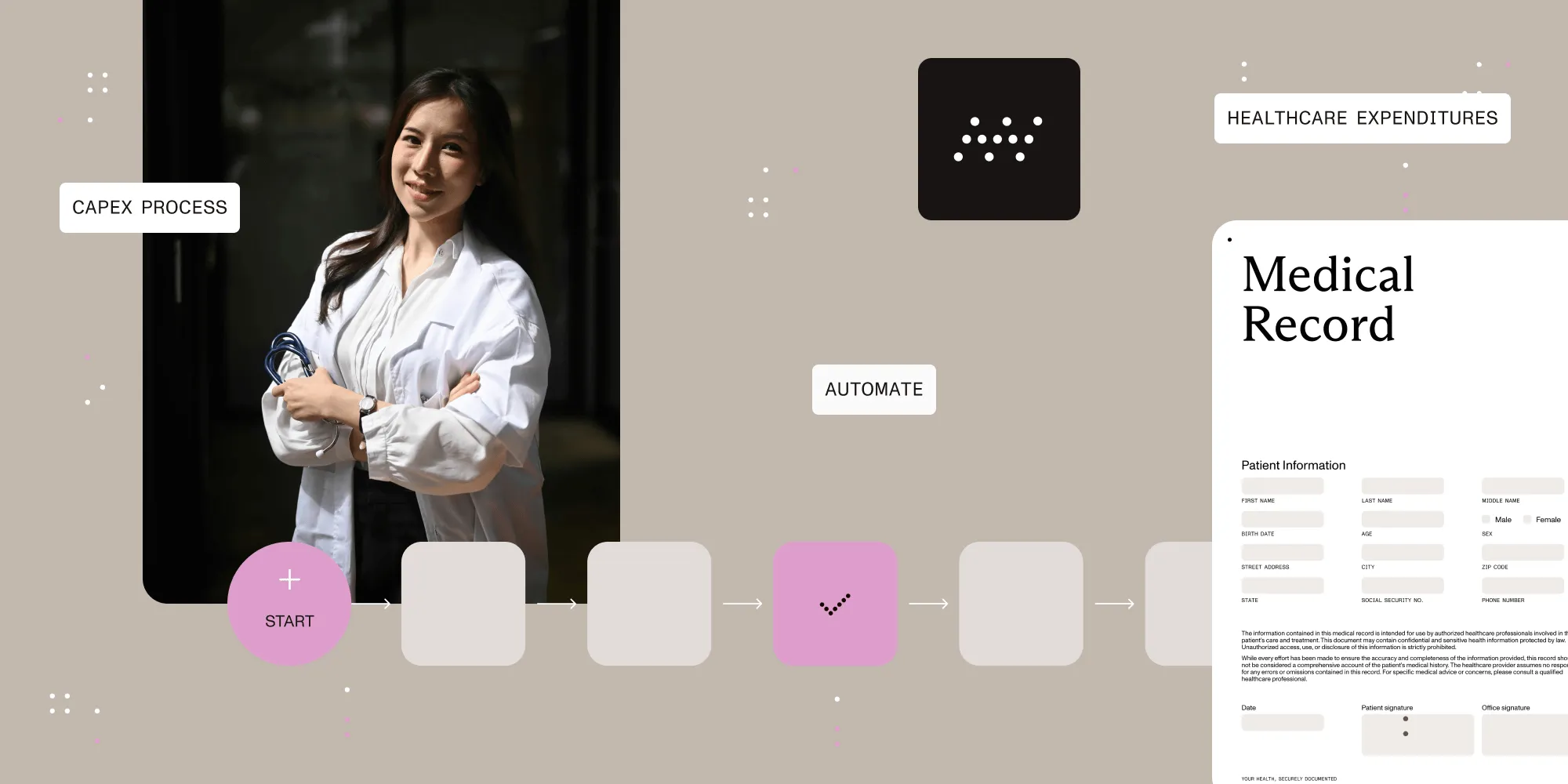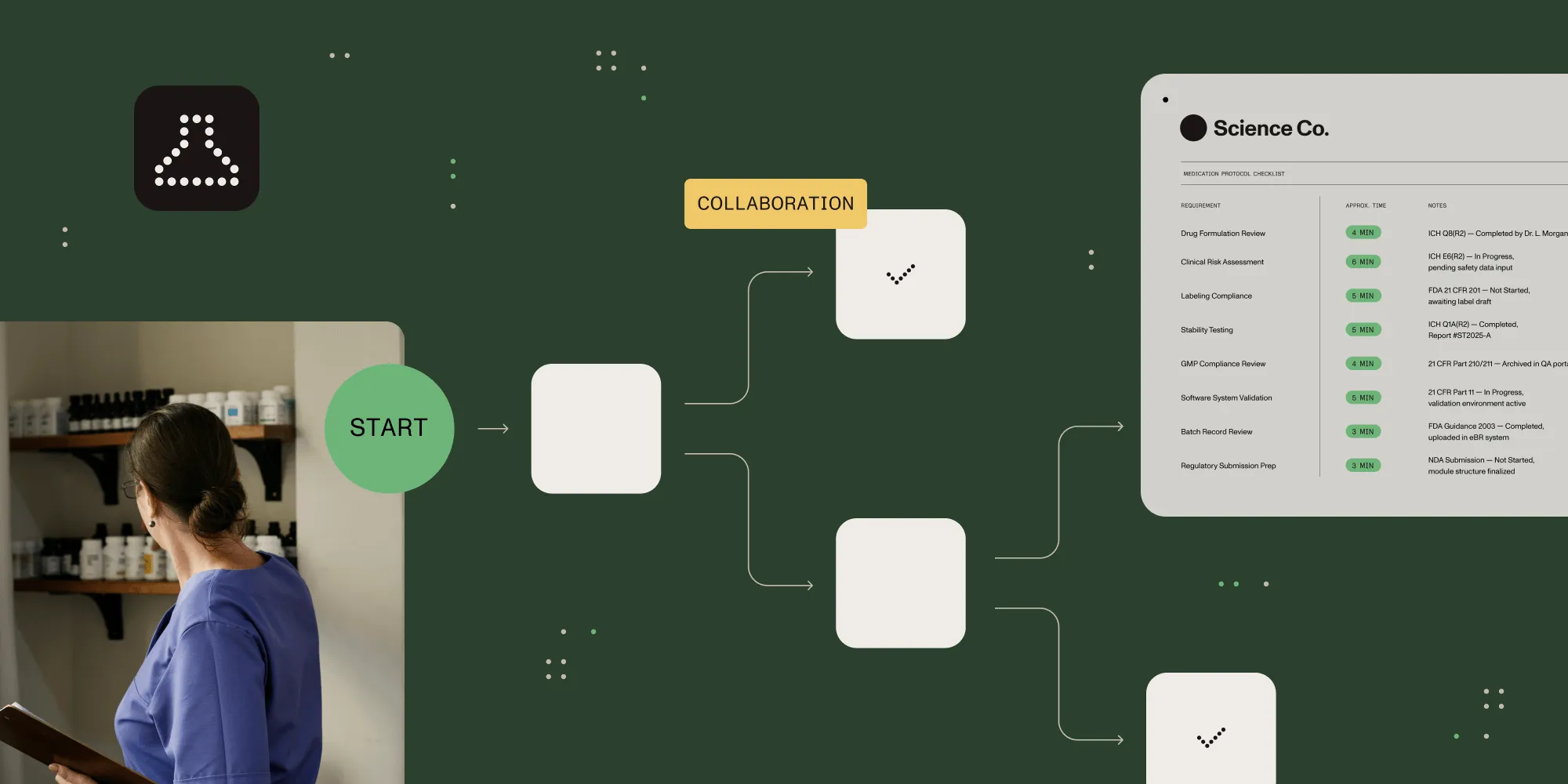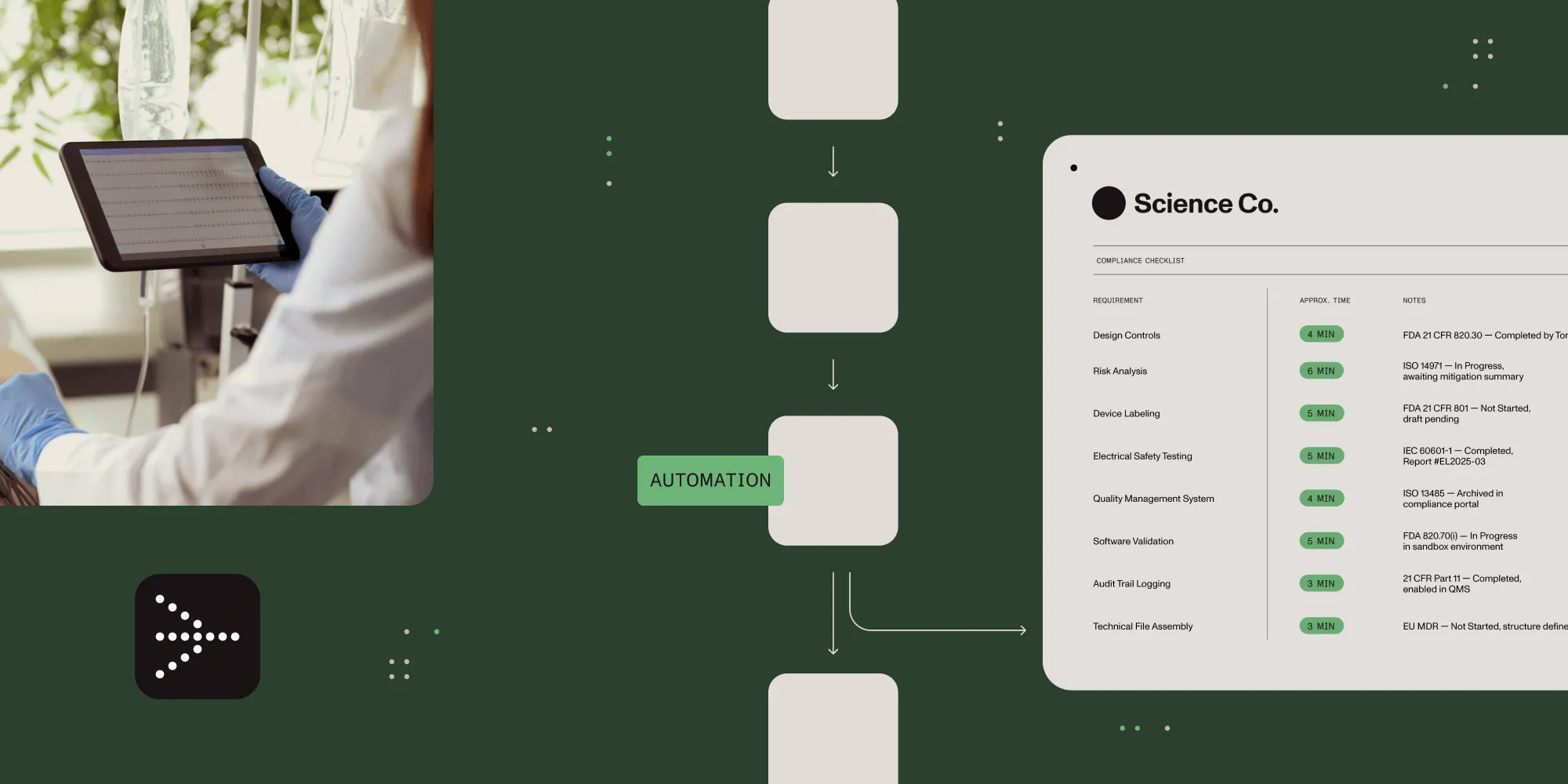Why healthcare organizations switch to automated CapEx approvals
Table of contents

Try Workflow Automation free for 14 days
In healthcare, capital expenditure — also known as CapEx — isn’t just a financial decision. It’s a critical investment that directly impact operations across the organization, from patient care to operational efficiency to company growth. And if you want your organization to thrive, the approval process needs to be as efficient as possible.
But here’s the thing: The CapEx approval process in healthcare is often bogged down by complex, manual workflows that can cause bottlenecks, slow down the approval process, and prevent your healthcare organization from securing the equipment and systems you need to deliver the highest standard of patient care.
The good news is that you don’t have to manage the CapEx approval process by hand. Workflow automation — and CapEx approval software in particular — changes how healthcare organizations manage their approval processes. This greatly reduces approval time, improves compliance and transparency, and boosts operational efficiency.
But how, exactly, can automated capital expenditure workflows improve these processes in healthcare? This post will take a look at everything you need to know: the problems manual processes present, and how those problems ultimately impact both patients and the organization; how automation can solve those problems; tips for automating CapEx approvals within your healthcare organization; and reaping the rewards that come with it.
Unique complexities of healthcare CapEx processes
Before jumping into automating healthcare CapEx processes, it’s first important to understand why CapEx processes in the healthcare industry are so complex.
Healthcare capital expenditures — including equipment, renovations, and IT — come with challenges that make them different from typical business investments. For example, “in tech, you’re mainly dealing with standardized equipment,” said Andrew Loukenath(opens in a new tab), a CFO with experience in healthcare. “In healthcare, every piece of equipment needs specific certifications, specialized maintenance contracts, and unique facility requirements.”
Healthcare capital expenditures are also complicated because there are a lot of “cooks in the kitchen” — they often involve multiple departments and stakeholders, as well as multiple levels of approval, which may have different priorities or opinions.
“Healthcare CapEx approvals are complex because they involve multiple departments — clinical, finance, IT, compliance — and each has unique priorities and metrics for success,” said financial strategist January Liddell(opens in a new tab).
For example, let’s say your hospital needs to purchase a new ultrasound system. In that situation, you’d need input and approval from multiple stakeholders like sonographers, radiologists, administrators, and finance teams before you can move forward with the purchase. Getting that input and approval can be extremely time-consuming.
There’s also the fact that healthcare is a high-stakes industry — for example, there are compliance and regulatory issues, and patient lives are literally at stake — so there are significantly more factors to consider compared to other industries, where the main considerations are cost and profit.
“Unlike many industries, healthcare must weigh not just ROI, but patient outcomes, regulatory compliance, and operational sustainability,” said Liddell. “You’re not just approving an equipment purchase — you’re evaluating its impact on care delivery, staff efficiency, and long-term budget planning. That level of nuance creates a slow-moving, high-stakes approval environment.”
IT vs. non-IT capital requests
Another complexity to consider? Healthcare organizations typically handle IT and non-IT capital requests differently.
Non-IT CapEx requests — like medical equipment or facility upgrades — tend to be more straightforward, as “they have clear physical outputs and tangible use cases,” according to Liddell.
On the other hand, “IT CapEx often comes with layered complexity,” she expanded. “It’s not just about cost, but integration. IT projects…require a deeper look at interoperability, cybersecurity, and long-term tech maintenance costs.”
And this layered complexity can add time as well as cost to the approval process.
For example, according to Loukenath, “a recent $1.5M EMR upgrade seemed straightforward until we realized it affected 15 other systems. The integration costs ended up being another $500K we hadn’t planned for.”
IT requests also require significant vetting, and any third-party technology vendors must also comply with the same regulatory standards as the organization itself. For example, EHR software, which stores patient data — including protected health information, or PHI — must comply with HIPAA.
However, it’s worth noting that non-IT requests aren’t without their own complexities. “Non-IT CapEx is typically more straightforward but comes with higher individual price tags,” Loukenath explained. “A new MRI machine isn’t just about the $3M equipment cost — you’re looking at facility modifications, staff training, and maintenance contracts that can add another 40 percent to the total investment.”
How manual CapEx processes hold healthcare organizations back
Essentially, healthcare capital expenditures are complex across the board. And manual processes present even more challenges.
Delayed approvals
One of the biggest issues with manual CapEx approval processes in healthcare is that they’re slow.
“Manual approvals slow everything down,” Liddell said. “You’re chasing paper trails, emails, or siloed spreadsheets,” which can stretch approval time far longer than it needs to be.
Loukenath experienced that slowdown firsthand. “Our approval process was taking 45+ days on average,” he said. “Department heads were submitting requests in different formats, missing crucial details, and we’d waste weeks just getting the basic information straight. The lack of standardization meant we couldn’t effectively compare competing priorities.”
And those delays aren’t just inconvenient; they can ultimately have a negative impact on outcomes. “At my previous organization, we lost a time-sensitive equipment deal because approval paperwork sat on someone’s desk for two weeks,” said Loukenath. “That mistake cost us $200K in missed early-bird pricing.”
Lack of visibility and transparency
“Pipeline visibility equals power,” said Loukenath. “Without clear insight, you’re basically throwing darts blindfolded.”
And manual processes? They make that visibility difficult, which can cause a cascade of issues.
“If finance leaders can’t see what’s coming down the pipeline, they can’t plan cash flow, negotiate vendor contracts effectively, or justify future investments,” Liddell said. And all of these things can cause issues with budgeting and resource management across the organization.
Plus, without all of the information, finance teams might apply formulations — like the CapEx formula — incorrectly, leading to inaccurate forecasts and budgets.
The bottom line? “CFOs in healthcare need real-time insight to manage tight margins and evolving regulations,” said Liddell. Without hospital finance automation, that real-time insight is nearly impossible.
Compliance and documentation risks
It doesn’t matter how smart or effective or detail-oriented members of your team are; they’re human and, as such, when you manage processes manually, mistakes will happen. This is a problem in any industry, but in healthcare, there are many rules to follow, and mistakes can be very costly.
Without automated systems, different departments may handle the approval process differently. This creates not only different processes, but also gaps in compliance that could cause problems later. Manual approval processes also run the risk of lost or incomplete documentation. It can be easy for a signature to be missed or a set of documents to be lost when it’s being moved from desk to desk. This can slow down the approval process, and it can also cause problems when audits are done.
How CapEx approval software can transform healthcare capital planning
Clearly, manual processes are just not ideal for healthcare capital expenditures approval. But there’s a better choice — one that solves all the problems caused by manual processes and makes the organization more efficient: workflow automation.
Automating workflows with CapEx approval software can improve the approval process in multiple aspects.
Streamlining approvals and eliminating bottlenecks
One of the biggest benefits of automating CapEx approvals is that it removes blockers and time-wasters that come along with manual management.
“Automation streamlines routing, tracks approvals, and eliminates the ‘who’s got the ball’ problem,” Liddell explained.
With automation, you can streamline the approval process in a variety of ways, including:
- Customized approval pathways — CapEx approval software lets you make custom approval workflows based on different things, like the request type, amount, or department. This can make each process more efficient and save a lot of time without losing accuracy or compliance. For example, “[our] system automatically routes requests based on amount tiers,” Loukenath said. “Anything under $100K gets fast-tracked — while bigger tickets get more scrutiny.”
- Automated routing — One of the biggest bottlenecks in manual approvals is waiting on signatures. With workflow automation, you can move requests automatically from one approver to another, eliminating manual handoffs, while saving time and energy. Plus, you can set up automatic reminders, so if any single approver is taking too long, it can remind them to sign and move the request along.
- Parallel reviews — As mentioned, with healthcare capital spending, there are often many departments and people involved. Many times, different teams will have to look at the spending during the approval process. With CapEx approval software, you can set up concurrent reviews, as opposed to having to wait for one review to finish before moving on to the next.
Using automation to streamline the process and eliminate these bottlenecks can have a huge impact on approval time. “Since implementing automation at my current organization, we’ve cut our CapEx approval time from 45 days to 12 days,” Loukenath shared.
Increasing visibility and transparency
Another benefit of automating healthcare capital expenditures approvals? Automation increases both visibility and transparency, which can positively impact the process.
- Catching bottlenecks, and catching them early — With manual processes, the lack of transparency can translate into redundancies or bottlenecks that spiral out of control before anyone is even aware of them. Automated systems can identify, flag, and resolve those bottlenecks early, increasing efficiency and keeping processes moving forward. As an example, Loukenath shared how “last summer, our automated system flagged $12M in requests stuck in middle management approval — something we’d have missed in our old manual process.”
- Increased accountability — Automation lets everyone see CapEx requests. This can help people understand what’s needed at any time. “When workflows are automated, every stakeholder can see where a request is in the process, what’s holding it up, and what’s been approved,” said Liddell. “This reduces confusion and improves accountability.”
- Better budget management — Having full access to the CapEx pipeline and real-time budget reports also gives finance teams a clear, up-to-date picture of the budget, including available resources, capital expenditures in progress, and planned spending. This can help them manage the budget better and make more informed decisions. “Visibility allows for smarter prioritization and allocation — especially when emergencies arise or funding changes,” said Liddell. Plus, “automated systems also generate data that helps organizations benchmark, forecast, and make more informed budgeting decisions in future planning cycles.”
- Accessibility — Automated systems keep all important CapEx information visible, organized, and accessible to teams. This can greatly improve results. “You can also attach supporting documents, track historical data, and report on trends — all within a centralized system,” Liddell said. “That kind of transparency isn’t just helpful; it’s essential for a sector like healthcare where resources are limited and accountability is critical.”
- Increased trust — Automation doesn’t just create visibility in the CapEx approval process; it also creates transparency, which is an absolute must in the healthcare industry, and, according to Liddell “vital for stakeholder trust and regulatory audits.”
Improving compliance and streamlining documentation
As mentioned, healthcare must follow the rules, including in documentation. Workflow automation can help make that compliance better and streamline in many ways, including:
- Comprehensive digital audit trails — CapEx approval software “ensures that every step — budget check, compliance review, departmental signoff — is completed in the right order, by the right person, and within the right time frame [and documented accordingly],” said Liddell. This creates a digital trail that makes audits a breeze. “When the board asks about a specific purchase, I can pull up the entire approval history, including all supporting documents and communications, in seconds,” Loukenath shared. “That level of documentation has saved us countless hours during audits.”
- Increased consistency — By automating the CapEx approval process, you can ensure every team, department, and employee is following the same process and creating, organizing, and storing data and documentation in the same way — creating consistency across the organization.
- Centralized documentation — With manual approvals, it’s easy for documents to get lost in the shuffle. In automated systems, all supporting documentation, from vendor quotes to clinical evaluations to meeting notes, is stored with the request in a single digital location, eliminating scattered paper files and email attachments, and ensuring you can access the information you need, when you need it.
- Automated compliance — With manual processes, there’s always a chance that an employee may not abide by regulatory standards (either purposefully or accidentally), increasing the risk of non-compliance. With workflow automation platforms, the system checks to make sure the whole process is in line with all internal and external rules.
Freeing up your team for strategic work
Clearly, automating healthcare capital expenditures can save significant time and energy over manual processes.
“I used to spend days manually consolidating CapEx data for forecasting,” Loukenath said. “Now it takes minutes.”
And when teams have more time and energy, it allows them to focus on what really matters — strategy.
Best practices for implementing healthcare CapEx automation
Considering implementing CapEx approval software in your healthcare organization? Here are a few best practices to keep in mind:
- Standardized from the start — When it comes to automation, “standardization is crucial,” Loukenath said. “We created templates for different types of requests — [for example], clinical equipment, IT infrastructure, [and] facility upgrades. Each template captures the specific data points needed for that category.” By standardizing workflows, and doing so early, you can ensure your automated processes are consistent across the organization.
- Get input from across the organization — As mentioned, with healthcare CapEx approvals, there are often a lot of different departments and stakeholders involved. As you design your workflows, it’s important to get input from all of those departments and people who need to know. This way, you can automate a process that works for everyone. “Bring IT, finance, clinical leadership, and compliance together early to design a workflow that works across all functions,” Liddell said.
- Prioritize integration — When looking for workflow automation platforms, it’s important to “look for platforms that integrate with your existing systems — EHRs, ERPs, and financial tools,” said Liddell. Not only will this offer a more seamless integration, but it’ll also help to avoid redundancies or duplication across different programs.
- Train your team — Teams can take a while to learn new systems. If your team used to manage CapEx approvals by hand, it’s worth spending time teaching them about your new processes and automation software. “Even the best system fails without buy-in,” said Liddell. “Invest in training so teams feel confident using the new tools.”
- Use the data to your advantage — If you want to use your automation platform well, you need to use the data it gives you. Use that data to plan your strategy. “Don’t just automate — analyze,” advised Liddell. “Leverage the reporting features to improve planning and future decision-making.”
Once you’re ready to implement workflow automation into your healthcare CapEx processes, take a look at how Nutrient Workflow Automation can transform your organizational success and outcomes. Then, check out our free trial, or contact Sales for a demo.







